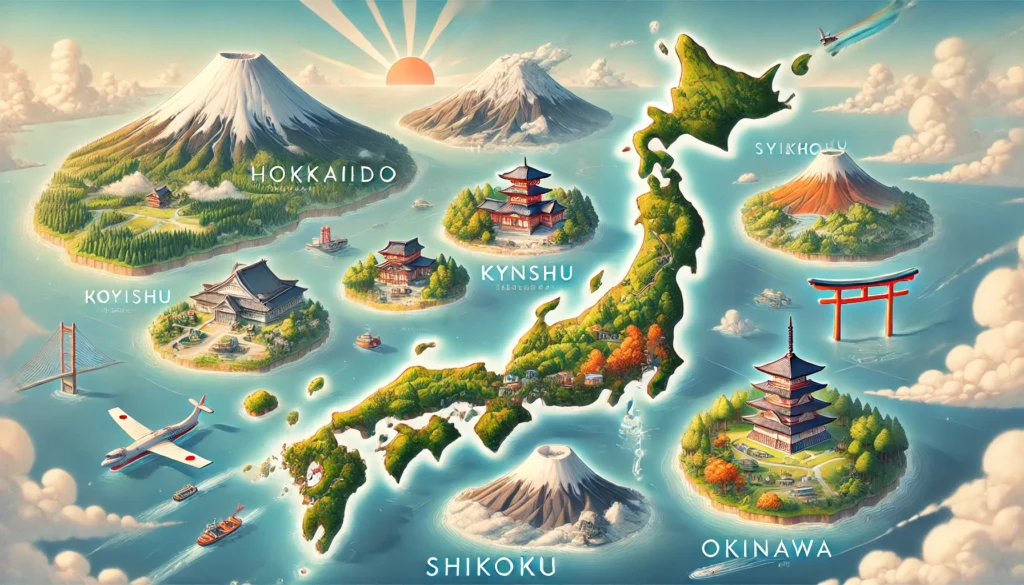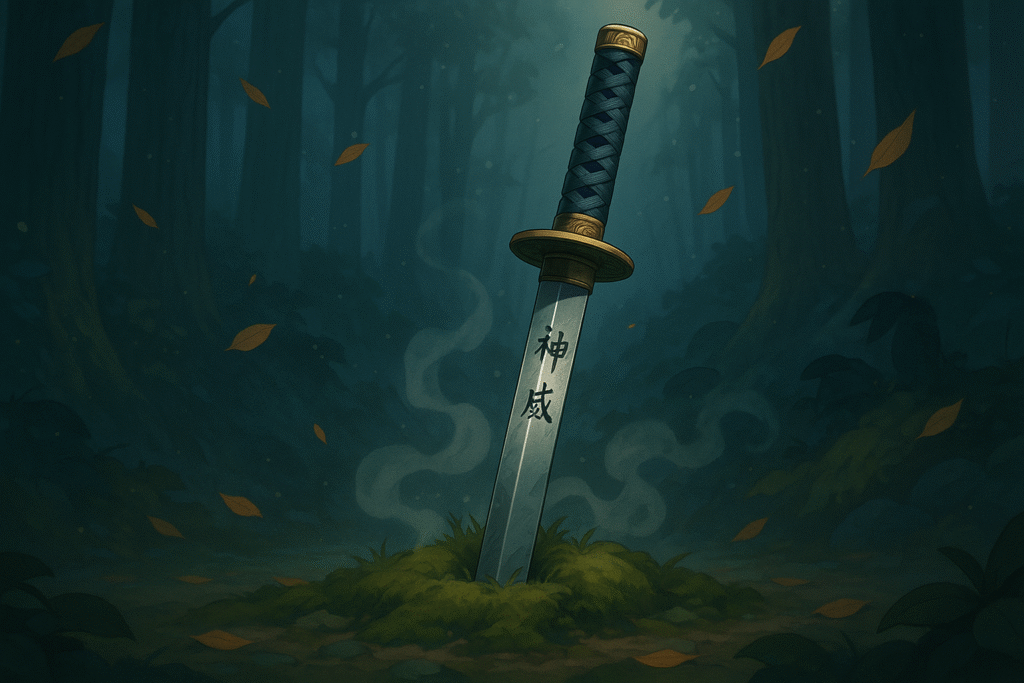Introduction
Japan, an island nation in East Asia, consists of thousands of islands, but five main islands dominate its geography, economy, and culture. These islands—Hokkaidō, Honshū, Shikoku, Kyūshū, and Okinawa—each have distinct landscapes, climates, and historical significance. This guide explores the main islands of Japan, highlighting their unique characteristics, regional differences, and key attractions.
1. Honshū: The Heart of Japan
Overview
- Size: 227,960 km² (largest island)
- Population: ~104 million
- Regions: Tōhoku, Kantō, Chūbu, Kansai, Chūgoku
- Major Cities: Tokyo, Kyoto, Osaka, Hiroshima, Nagoya
Honshū is Japan’s largest and most populous island, serving as the country’s political, cultural, and economic hub. Tokyo, the capital city, sits on Honshū’s eastern coast, forming part of the Pacific Belt, a densely populated urban corridor extending from Tokyo to Fukuoka in Kyūshū.
Key Features of Honshū
- Diverse Geography: From the Japanese Alps to coastal plains, Honshū offers varied landscapes.
- Cultural Centers: Kyoto and Nara are historic capitals with centuries-old temples and shrines.
- Economic Powerhouse: The Kantō region, particularly Tokyo and Yokohama, drives Japan’s economy.
- Hiroshima & Peace Memorial Park: A poignant reminder of World War II’s impact.
- Natural Wonders: Mount Fuji, Japan’s highest peak and a UNESCO World Heritage site, lies in central Honshū.
2. Hokkaidō: Japan’s Northern Frontier
Overview
- Size: 83,454 km²
- Population: ~5.2 million
- Major City: Sapporo
Hokkaidō is Japan’s second-largest island, known for its vast wilderness, national parks, and cooler climate. It is home to rich biodiversity, making it a haven for outdoor enthusiasts.
Key Features of Hokkaidō
- Winter Wonderland: Sapporo Snow Festival attracts visitors with its elaborate ice sculptures.
- National Parks: Shiretoko National Park is a UNESCO World Heritage site.
- Ski Resorts: Niseko is a world-famous ski destination.
- Fresh Seafood: Hokkaidō is renowned for its seafood, particularly crabs and scallops.
- Ainu Culture: The indigenous Ainu people have a rich cultural heritage preserved in places like Upopoy National Ainu Museum.
3. Kyūshū: The Gateway to Asia
Overview
- Size: 36,782 km²
- Population: ~14.3 million
- Major Cities: Fukuoka, Nagasaki, Kumamoto, Kagoshima
Kyūshū, the southernmost of Japan’s four main islands, has played a crucial role in the country’s history due to its proximity to China and Korea. It is known for its warm climate, volcanic activity, and vibrant cities.
Key Features of Kyūshū
- Fukuoka: A dynamic city with great food, including famous Hakata ramen.
- Hot Springs: Beppu and Yufuin offer some of Japan’s best onsen (hot springs).
- Volcanoes: Mount Aso has one of the world’s largest volcanic calderas.
- Nagasaki: Historically significant as one of Japan’s earliest international trade ports and the second city hit by an atomic bomb.
- Traditional Crafts: Kyūshū is known for ceramics, such as Arita and Imari porcelain.
4. Shikoku: The Pilgrimage Island
Overview
- Size: 18,801 km²
- Population: ~3.8 million
- Major Cities: Matsuyama, Takamatsu, Tokushima, Kōchi
Shikoku is the smallest of Japan’s four primary islands, often overlooked by travelers but rich in tradition and natural beauty.
Key Features of Shikoku
- 88 Temple Pilgrimage: A historic Buddhist pilgrimage route covering 1,200 km.
- Naruto Whirlpools: Massive whirlpools created by tidal currents in the Naruto Strait.
- Shimanami Kaidō: A scenic cycling route connecting Shikoku to Honshū.
- Rural Beauty: The Iya Valley offers breathtaking gorges and traditional thatched-roof houses.
5. Okinawa: A Tropical Paradise
Overview
- Size: 1,199 km²
- Population: ~1.3 million
- Major City: Naha
Okinawa, the smallest of Japan’s main islands, is the largest in the Nansei (Ryūkyū) Islands chain, extending from Kyūshū toward Taiwan. Unlike the rest of Japan, Okinawa has a subtropical climate and a distinct cultural heritage.
Key Features of Okinawa
- Unique Culture: Okinawa has a separate language and history, influenced by its past as the independent Ryūkyū Kingdom.
- Beautiful Beaches: Crystal-clear waters and coral reefs make it a top diving and snorkeling destination.
- Historic Sites: Shurijō Castle (partially destroyed in 2019) symbolizes Okinawa’s rich past.
- Longevity Secrets: Okinawans have one of the highest life expectancies in the world.
- World War II History: The Battle of Okinawa was one of the fiercest battles of the Pacific War, with sites like the Peace Memorial Park commemorating the events.
Beyond the Main Islands: The Nansei & Nanpō Archipelagos
In addition to the five main islands of Japan, two important island chains extend the country’s maritime reach:
Nansei Islands (Ryūkyū Archipelago)
- Location: Southwest of Kyūshū to Taiwan
- Divisions: Satsunan Islands, Okinawa Islands, Sakishima Islands
- Famous Islands: Amami, Miyako, Ishigaki, Yonaguni
Nanpō Islands
- Location: Stretching southward from Tokyo into the Pacific
- Divisions: Izu Islands, Ogasawara Islands, Volcano Islands
- Notable Features: Ogasawara Islands (UNESCO World Heritage Site), Iwo Jima’s WWII history
Conclusion
The main islands of Japan each offer unique landscapes, climates, and cultural experiences. From Hokkaidō’s snowy wilderness to Honshū’s bustling metropolises, Shikoku’s tranquil temples, Kyūshū’s volcanic landscapes, and Okinawa’s tropical beaches, these islands shape Japan’s rich and diverse identity.
Whether exploring Japan’s deep history, breathtaking nature, or vibrant cities, understanding its geography enhances the experience of this fascinating country.
Discover More About Japan & Japanese Culture 🇯🇵✨
Looking for more insights into Japanese life, language, and travel? Check out these must-read articles from Wakoku:
📖 Japanese Language & Learning Resources
🔹 Mastering Japanese Alphabet Pronunciation – Learn how to pronounce Japanese characters correctly.
🔹 A Beginner’s Guide to Writing Hiragana Characters – Start writing hiragana with confidence.
🔹 Learn Japanese Kanji Basics: A Beginner’s Guide – Master the foundations of kanji efficiently.
🔹 How to Type Japanese Letters Easily – Learn to type Japanese on your keyboard like a pro.
🔹 How to Say “Hello” in Japanese: The Ultimate Guide to Japanese Greetings – Learn essential Japanese greetings and when to use them.
🏯 Japanese Culture & Traditions
🔹 Experiencing a Traditional Japanese Bathhouse – Discover the etiquette and relaxation of Japanese sento and onsen.
🔹 Essential Drinks Vocabulary in Japanese: Order Like a Pro – Learn how to order your favorite drinks in Japan.
🔹 Mastering Nature Vocabulary in Japanese: A Comprehensive Guide – Expand your Japanese vocabulary with nature-related words.
🚀 Travel & Living in Japan
🔹 The Pros and Cons of Living in Japan: What You Need to Know Before Moving – Understand the ups and downs of living in Japan.
🔹 Kyoto Illumination 2024-2025: A Magical Winter Light Experience – Explore Kyoto’s stunning winter light displays.
🔹 Spas to Visit in Osaka: A Guide to Relaxation in Osaka – Find the best spas for unwinding in Osaka.
🗻 Adventure & Exploration
🔹 Japanese Seafood Names: A Comprehensive Guide for Seafood Lovers – Learn the names of seafood in Japanese for dining and shopping.
🔹 Expand Your Japanese Fruits Vocabulary – Discover common and unique Japanese fruit names.




